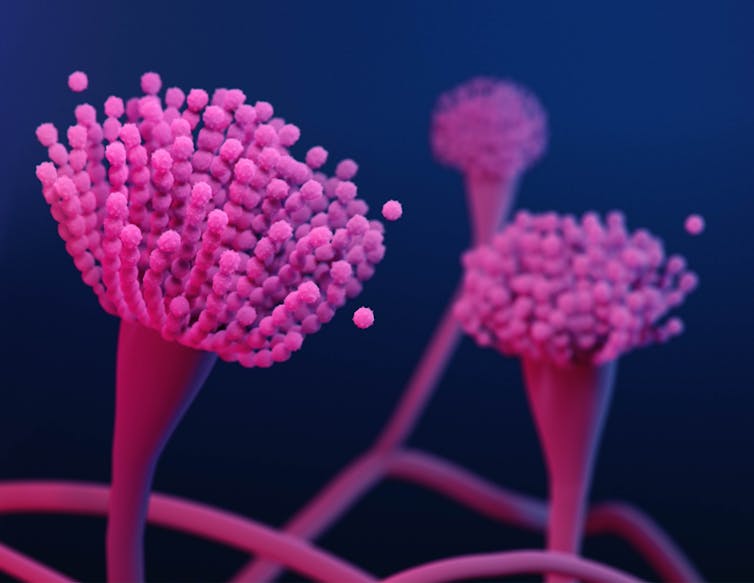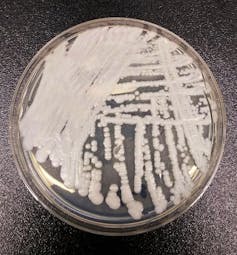
Experts in autocracies have pointed out that it is, unfortunately, easy to slip into normalizing the tyrant, hence it is important to hang on to outrage. These incidents which seem to call for the efforts of the Greek Furies (Erinyes) to come and deal with them will, I hope, help with that. As a reminder, though no one really knows how many there were supposed to be, the three names we have are Alecto, Megaera, and Tisiphone. These roughly translate as “unceasing,” “grudging,” and “vengeful destruction.”
Well, this is scary. I have known about Candida albicans for quite some time – 40-60% of us have some somewhere in our gut, but our immune systems generally keep it in check. In the mid-eighties, when DH and I both started allergy treatment, we were routinely tested for it; because of allergies tying up the immune system, it can get out of control if you have some, and especially food allergies. It was then treated with nystatin or some similar drugs,
I certainly never knew that, or why, it’s so hard to come up with antifungal drugs that aren’t as bad as the fungus itself. Candida albicans, the Candida which causes “thrush,” used to be considered annoying, but controllable. No one knew about these other strains of Candida Boy, have things changed! And rapidly!
=================================================================
Why the CDC warns antibiotic-resistant fungal infections are an urgent health threat

Stephanie Rossow/CDC
Cornelius (Neil) J. Clancy, University of Pittsburgh
In 2013 I took care of a gentleman who underwent surgery for what all his physicians, including me, thought was liver cancer. Surgery revealed that the disease was a rare but benign tumor, rather than cancer. As you might imagine, he and his family were overjoyed and relieved.
However, two weeks after this surgery, he developed a liver abscess – an encapsulated tissue infection. Surgeons operated to remove the abscess. Two days later, test results revealed that the abscess was caused by a fungus called Candida that was resistant to echinocandins, our most powerful drugs against this fungus.
The patient underwent multiple surgeries and received various antibiotics thereafter, but his abscess kept growing back. He died four weeks after the first surgery to remove the abscess. The cause of death was sepsis due to his echinocandin-resistant Candida infection, which, at the time, was uncommon in the U.S. This tragic case demonstrated to me firsthand the devastating impact of drug-resistant fungal infections.
In the years since, I have cared for over a dozen patients who have died due to antibiotic-resistant fungal infections. On Nov. 13, 2019, the Centers for Disease Control and Prevention released a report on antibiotic resistance threats in the U.S., warning that drug-resistant fungi have become major public health problems.
The new report revealed that 18 microorganisms cause almost 3 million antibiotic resistant infections and 35,000 deaths annually. For the first time, this report includes several antibiotic resistant fungi: Candida auris, other drug-resistant Candida (as in my patient above) and azole-resistant Aspergillus fumigatus. These resistant fungi are especially threatening because only three classes of antifungal medicines are currently available.
Antibiotic-resistant fungi?
We have heard a lot in recent years about the public health crisis of antibiotic-resistant bacteria, but less attention has been paid to antibiotic-resistant fungi. In part, this is because fungi became common causes of disease only over the past 30 years. During this time, the risk for serious fungal infections rose as more people suffered weakened immune systems stemming from increased bone marrow and organ transplantation, new drugs to treat cancer and other diseases, and complex surgeries. The widespread use of more potent antibiotics to treat resistant bacterial infections also has contributed by creating less competition for fungi to grow in human tissues.

Shawn Lockhart/ CDC/ NCEZID; DFWED; MDB
Fungi include yeasts, which grow as spherical cells; and molds, which grow as elongated, tubular cells. Both yeasts and molds are more closely related genetically to humans than they are to bacteria. Therefore, it is hard to develop antibiotics that attack fungi without damaging human cells.
Candida are yeasts that commonly cause skin rashes, urinary tract infections and vaginal infections. However, they are also the third-leading cause of sepsis and other life-threatening infections in U.S. hospitals.
Candida auris was discovered in 2009, but it was almost never encountered in a medical setting until 2015, when numerous infections suddenly occurred on multiple continents. It is now one of CDC’s five most “urgent threats” for two principal reasons.
First, it demonstrates very high-level antifungal resistance. Ninety percent of strains are resistant to fluconazole, the frontline antifungal in many countries; 30% are resistant to two antifungal classes; and between 3% and 5% to all antifungals.
Another reason that the CDC is concerned about C. auris is that it has the unique ability to spread from person to person through contact with hands and clothes of health-care workers or contaminated medical devices. It also persists outside of humans in health-care environments, and causes large, long-standing infectious outbreaks. C. auris is a remarkably robust organism that can survive standard disinfection methods, high temperatures and salt solutions that kill other microbes.
Since the first U.S. case in 2016, C. auris has caused more than 800 infections in 13 states. CDC and local health departments currently are working to contain numerous health-care outbreaks. It is unclear why this fungus has arisen now, although climate and other environmental changes may have played a role. Likewise, it is unclear how widely C. auris will expand in the U.S. or globally.
It’s not just C. auris we need to worry about

Dr. David Midgley., CC BY
Other drug-resistant fungi in the Candida family are also considered “serious threats” by CDC. These strains cause more than 34,000 infections annually, more than are caused by C. auris, but they are less likely to spread from person to person and cause outbreaks. Nevertheless, deeply invasive C. auris and other drug-resistant Candida infections are similar in severity, resulting in the death of 40% of patients.
Another dangerous fungus species the CDC singled out is Aspergillus fumigatus, which is a mold found in soil and vegetation that releases spores that most people inhale daily without problems. However, people with weakened immune systems – especially cancer patients or transplant recipients – can develop lung or other organ infections that kill between 50% and 75% of infected patients.
Azole antifungals are the only drugs that kill A. fumigatus without causing serious side effects. Azoles also are used widely in agriculture. Azole-resistant A. fumigatus infections are most common in Europe, where they have been linked to agricultural and patient use. Although these infections still are uncommon in the U.S., CDC has placed azole-resistant A. fumigatus on its “resistance watch list” because azole use is so widespread in this country and vulnerable patient populations are large.
Tackling antibiotic-resistant fungi requires many strategies
How is the U.S. fighting antibiotic-resistant fungi? CDC and health departments are leading the way in surveillance for resistance and, in the case of C. auris, outbreak containment and prevention. Containment involves rapid and accurate diagnosis of C. auris infections, and the use of hospital gowns, gloves, equipment and cleaning materials that reduce the likelihood of spreading the fungus.
Various U.S. government agencies have funded research that is leading to new antifungal drugs and improved diagnostic tests.
Organizations that grade the quality of medical care for the public now require health-care facilities to have antibiotic stewardship programs that reduce inappropriate prescribing and development of resistance.
Efforts are underway also to control antibiotic use in agriculture and animals, since resistance cannot be tackled by only focusing on human medicine. CDC and other U.S. agencies are working closely with international partners, because antibiotic-resistant microbes do not recognize geographic borders. Finally, the crucial first step in tackling a problem is to recognize it, which is why the CDC report on antibiotic resistance threats is so important.
[ Deep knowledge, daily. Sign up for The Conversation’s newsletter. ]![]()
Cornelius (Neil) J. Clancy, Associate Professor of Medicine and Director of Mycology, University of Pittsburgh
This article is republished from The Conversation under a Creative Commons license. Read the original article.
=================================================================
Alecto, Megaera, and Tisiphone, this is an area which demonstrates quite vividly why we need to fund medical research – despite the machinations of all those who would defund it completely.Please! Help!
The Furies and I will be back.
12 Responses to “Everyday Erinyes #193”
Sorry, the comment form is closed at this time.

Scary, indeed! Weakened immune systems suck, but, if a person has one, because of previous life-saving treatment, at least one is still around experiencing whatever his/her life can bring by way of positive stuff. It’s a crap shoot, I suppose, and none of us are getting out alive.
Gawd, this is frightening.
I’m concerned with the notion of not being able to contain or control the antibiotic-resistant fungi. The serious threats as defined by CDC, and the number of deaths is scary too.
This is a noteworthy informative post, which I will save, and send off to F&F.
This surely is something that folks need to review, and read.
Thanks, Joanne (and Furies) for getting this info out to us, and others.
Keep up the good work.
Dang JD, you have me worried, considering all the trouble I’m having with my gut!
I won’t say I’m not concerned for you/But remember, the strain that’s in everyone’s guts is a different strain from the one in the first case that was shared,. which rpresented in the liver and was thought to be a tumor.
I lost one friend, post breast cancer to one a number of years ago. Another last year, with two who survived theirs. Three acquired in a hospital.If we made the health system public, we could ensure more drug research and development went to such threats.
Wow….this is really scary. Knowing that I will be having that operation in January, makes me even more scared about having to go into the hospital operating room. Pray that they can get a better way to prevent this major issue.
Thanks Joanne
Antibiotic resistant organisms are a huge problem and concern in the responsible medical community for decades – and now in the community at large.
I was in a four-man group and one of the senior partners would treat every illness w/ an antibiotic – even sight-unseen. His patients were so conditioned that it made being on-call a misery. They would call and DEMAND an antibiotic be called out for a runny nose.
He eventually left the group and went solo. Made our lives easier, but didn’t help w/ his dangerous practice of handing out antibiotics willy-nilly.
Yes. I’ve been avoiding antibiotics for years, mostly successfully, and preaching the idea when and where I can. I just assumed (and, yes, I know how assume breaks down, and I admit it applies here) that if bacteria were treated with antibiotics, and viruses with antivirals (to the extent that we have any), fungi would be treated with anti-fungals. It never occurred to me that any fungi would have to be treated with antibiotics – heck, over half of our antibiotics are fungi, or so I thought.
I’m curious how you were informed that “over half of our antibiotics are fungi”.
I suppose it’s possible they mean by the number of prescriptions written – although even that seems a stretch to me. But if they mean actual antibiotics, that estimate is way off.
Sorry to disappoint, but at present only three broad antibiotic types are produced by fungi:
Penicillin (from Penicillium chrysogenum)
Cephalosporin (from Cephalosporium acremonium)
Griseofulvin (from Penicillium griseofulvum)
http://archive.bio.ed.ac.uk/jdeacon/microbes/penicill.htm
https://pdfs.semanticscholar.org/0110/27e6c96bd9c6da20c3e87b56521b806310c6.pdf
https://mmbr.asm.org/content/mmbr/41/3/595.full.pdf
https://books.google.com/books?id=IQZFDwAAQBAJ&pg=PA421&lpg=PA421&dq=Fungi+penicillin+cephalosporins+griseofulvin+%22Cephalosporium+acremonium%22+%22Penicillium+chrysogenum%22+%22Penicillium+griseofulvum%22&source=bl&ots=1-kvQTecco&sig=ACfU3U39vnHCXW1FkyPX5M8qahLptj0U1Q&hl=en&ppis=_e&sa=X&ved=2ahUKEwj42fmrgITmAhULsZ4KHYHTAsEQ6AEwE3oECA8QAQ#v=onepage&q=Fungi%20penicillin%20cephalosporins%20griseofulvin%20%22Cephalosporium%20acremonium%22%20%22Penicillium%20chrysogenum%22%20%22Penicillium%20griseofulvum%22&f=false
Since it’s more of an impression than a statistic, I’m sure it comes from what’s commonly prescribed … and more specifically, what’s commonly prescribed among people I know/know of, which limits the pool substantially.
As always, thanks for the education. Always happy to increase my knowledge.
A very interesting but rather frightening article, Joanne.
When I couldn’t get on top of my cellulitis at the beginning of this year, the doctor kept prescribing me different antibiotics and said he’d continue until he found one that did the job. It worried me a lot that he kept prescribing me different ones, first because I’ve stayed away from antibiotics conscientiously most of my life and secondly because I thought I’d become resistant to them with all these prescriptions. Until it dawned on me that it wasn’t me that was becoming resistant, but the bacteria and fungi. And they hadn’t necessarily become resistant in my body but might be strains that had developed resistance elsewhere through antibiotics ending up in drinking water, fed to animals in the meat industry and such, and were introduced to my body through a cut or laceration.
A double whammy if one would enter a hospital with a weakened immune system and then get infected with a CRE(Carbapenem-resistant Enterobacteriaceae) they can’t eradicate.
I’ve not added to the problem with letting my waste products full of antibiotics enter the waste-water system; I have a septic tank. Though I worry a bit that the functioning of said tank is compromised by so much bacteria killers. 🤔😉
“the doctor kept prescribing me different antibiotics and said he’d continue until he found one that did the job”
Yes – and isn’t that scary. By avoiding antibiotics personally, as yo (and I) have done – and it is the right thing to do – but you don’t necessarily gain personal protection even though you are personally not making the problem worse. If others are, and the bacteria evolve, you may be just as endangered as if you had And I might add that, though the problem would exist without climate change, climate change is not making it any better.